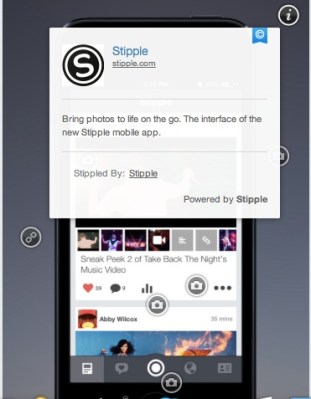Image tagging startup Stipple is announcing two new products today — Stipple Search, which allows anyone to identify the owner of an image, and Stipple Mobile, a smartphone photo app.
Stipple’s technology identifies images and adds tags that can point to related content. For example, this image of Stipple Mobile includes tags for related photos, a link to the app itself, and a note indicating that the image originated with Stipple. Publishers can use these tags to enrich their content while advertisers can use them to deliver their message in a new, relevant context — a movie studio could advertise a new release on images of the movie’s stars.
Stipple Search uses similar technology, but for the purpose of “reverse image search” — uploading an image and then getting results that show where the image came from. Basically, co-founder and CEO Rey Flemings said that if you upload an image to Stipple Search, and if one of Stipple’s partners (like Getty Images) has tagged the image in the Stipple system, then you should see all of those tags.
Flemings noted that until now, “the only way that you’ve been able to see Stipple work its magic is if you are a publisher.” But anyone who finds an interesting image on the web can go to Stipple Search and find additional information, such as links that allow you to buy the products featured in a photo.
Google Images also includes a reverse image search option, but as Flemings illustrated in his demo, Google is just locating other uses of the same image — Stipple is actually retrieving useful data.
This is also an interesting “attribution play,” Flemings said, because it’s now easier to track down the owner of an image and ask them for permission to use it. And it gives image owners even more reason to work with Stipple, since the company’s data is now accessible outside of its publishing partnerships.
As for the new Stipple Mobile iOS app (Android is in the works), Flemings said the goal isn’t necessarily to compete with existing photo-sharing apps, but rather to turn Stipple Mobile into the initial app you use for uploading photos, which are then shared elsewhere. Currently, users can add tags to their images in Stipple Mobile then share them on Facebook and Twitter — Flemings argued that this gives them more ownership over those images, because the information that they wanted to share will remain attached as the image gets shared and re-shared.
“This notion of, I create content on pick-your-content-flavor-of-day mobile photo sharing app, that content effectively belongs to the network,” he said. Flemings added that both Stipple Search and Stipple Mobile tie into the company’s larger vision: “We want to be the source of information about the web’s photos.”
